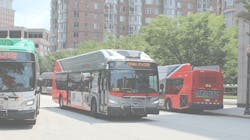NVTC report makes recommendations on how to improve bus service
A new report from the Northern Virginia Transportation Commission (NVTC) analyzes bus service in northern Virginia and makes recommendations for how to make buses faster and more reliable for riders. The report, titled Advancing Bus Priority, features an interactive story map that allows users to visualize how infrastructure improvements would reduce traffic congestion for buses.
Congestion hurts buses
Traffic congestion lengthens trips, decreases reliability and increases costs. Buses get stuck in traffic just like cars and since they carry more people, a bus stuck in traffic affects more people. Prioritizing buses on the road moves more people faster.
What does bus priority look like?
Bus priority treatments, like dedicated bus lanes, transit signal priority or queue jumps, are improvements made to the roadway to increase reliability, reduce delays and even increase safety.
Why bus priority matters
"Congestion-related bus delays are estimated to cost the region nearly $19 million each year," said NVTC Transit Resource Center Senior Program Manager Xavier Harmony. "While fares stay the same, the cost of a trip can increase as buses sit in traffic. Adopting bus priority measures could lower the economic and travel time costs for transit agencies, local governments and riders."
How does the Advancing Bus Priority help buses stuck in traffic?
The Advancing Bus Priority report helps:
- Identify routes and corridors for study of potential new bus rapid transit corridors.
- Highlight opportunities for transit agencies and jurisdictions to collaborate and combine resources to overcome shared bus operation issues.
- Leverage the regional nature of northern Virginia bus to achieve shared benefits.
The full Advancing Bus Priority report can be viewed on NVTC’s website.
